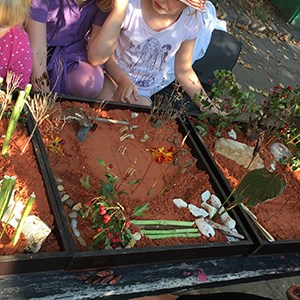Contact
Lena Jungmark Coordinator
The unit for Collaboration and Development, SLU

Schools that relocate the classroom outdoors can expect a large number of positive effects. In addition to reducing the spread of infection, research shows that teaching conducted outdoors rapidly improves the pupils’ concentration, working memory and motivation to study. Pupils who have nature as a classroom are less stressed, move about more, and show better academic achievement in school.
At the time of writing, almost all schools in Europe are closed as a result of the COVID-19 pandemic. In Sweden, our preschools and primary schools remain open, while the teachers and pupils do their best to comply with the recommendations given by Public Health Agency of Sweden to reduce the spread of the virus. One of the suggestions concerning preventive measures to guard against respiratory infections is to “consider the possibilities of taking the educational activities outdoors and increasing the breaks outdoors. Not only activities in preschools and after-school centres, but also some teaching such as physical education may have greater possibilities to be carried out outdoors.”
Researchers at the Swedish University of Agricultural Sciences (SLU) have studied young children’s and adolescents’ outdoor environments – schoolyards, playgrounds and other places for play and learning, for decades. At SLU, landscape architects, environmental psychologists, urban planners, nature guides and many more professions and disciplines are working on issues concerning how to plan, design and incorporate the children’s perspectives in both research and teaching.
“Right now, a window opens up for educators and pupils to try out the benefits of wide open spaces for education, taking the classroom outdoors. At the same time as we reduce the risk of spread of infection by being outside in the open air, we can take advantage of the benefits of teaching outdoors. Outdoor education programmes are a good complement to (indoors) school teaching, as it builds bridges between theory and action-based experience,” says Lena Jungmark, national coordinator for issues related to children’s and young people’s outdoor environments.
Since 2006, the think tank at SLU Movium, where Lena Jungmark is employed, has been tasked with developing and coordinating knowledge of children’s outdoor environments. Movium has been working on urban development issues for 40 years (celebrating its jubilee this year) and has the issue of children’s spaces in the city as one of its focus areas.
In her research, Fredrika Mårtensson, Senior Lecturer at the Department of Work Science, Business Economics and Environmental Psychology at SLU Alnarp, has shown how nature in children’s everyday life constitutes a factor in maintaining good health with an impact on their play, learning, and health. The studies show that preschool children with access to spacious, green and varied outdoor environments have better concentration and sleep better at night, increased general well-being, and fewer incidence of infections – and the greatest effects are the socio-economically vulnerable residential areas. For school-age children, a green environment improves the psychosocial climate in the schoolyard. However, the increased physical activity of children when teaching moves outdoors also poses challenges for the teachers:
“When the classroom lessons move outdoors, the children become more curious and mobile, they are moving about in both body and mind, and it becomes a challenge for teachers to design tasks that take advantage of their enjoyment of motion,” explains Fredrika Mårtensson.
What has been shown to be best is to leave it to the children to choose how to use the outdoor environment to solve different tasks. Alnarp’s Landscape Laboratory, a unique urban forest and outdoor laboratory, is now establishing grounds with high play values together with children and experts in ecology and design. Systematic studies have also been done to compare how nature and various prefabricated and digital elements affect children’s activity.
“There is a need for places with potential for play and learning in children’s immediate environment, and a fundamental task for research is to find out how to integrate contact with flora and fauna into children’s everyday lives,” comments Fredrika Mårtensson.
Petter Åkerblom, Senior lecturer in Landscape Architecture at the Department of Urban and Rural Planning, SLU Uppsala, is the editor of the knowledge overview: Klassrum med himlen som tak [Teaching with the Sky as the Ceiling] (2018), a collaborative project with the think tank Movium at SLU and Linköping University, on behalf of Utenavet. Research is presented here that shows how regular physical activity and contact with nature during school day generate a number of positive effects. Better concentration, working memory, and study motivation are only some.
“Nature is an excellent classroom. Relocating part of the teaching increases pupils’ academic achievement. But in and of itself contact with nature is also good for the health and well-being of primary school pupils, as well as for their personal and social development. In the long run, self-esteem, impulse control, creativity, and the facility to engage in cooperation with others are strengthened,” explains Petter Åkerblom.
Nature and urban landscapes offer alternative learning venues where pupils have direct contact with the community and society-at-large. The fact that the pupils move about itself produces a positive impact on learning and personal development. A national survey shows that only 44% of boys and 22% of girls attain the recommendation to move about at least one hour per day.
Teaching with the Sky as a Ceiling studies and compiles a large number of scientific publications and the evidence is strong.
“The scientific support is sufficiently strong enough that outdoor education should be implemented throughout the educational system at all levels, so as to contribute to better achievement of learning objectives and better grades,” remarks Petter Åkerblom.
Lena Jungmark Coordinator
The unit for Collaboration and Development, SLU